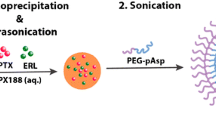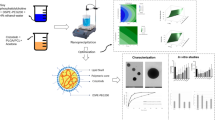Abstract
Background
Platinum-based chemotherapy in non-small cell lung cancer (NSCLC) has been demonstrated as a promising approach by many researchers. However, due to low bioavailability and several side effects, drug targeting to lungs by intravenous administration is not a common route of administration.
Objective
In this study, oxaliplatin loaded polycaprolactone (PCL) nanoparticles were prepared to overcome the limitations of the drug. 33 factorial design was used to evaluate the combined effect of the selected variables on the nanoparticle characteristics and to optimize oxaliplatin loaded PCL nanoparticles.
Methods
The factorial design was used to study the influence of three different independent variables on the response of nanoparticle particle size, polydispersity index (PDI), zeta potential, and encapsulation efficiency. The cellular uptakes of oxaliplatin loaded nanoparticles with different molecular weights of PCL were evaluated. Moreover, optimized nanoparticles were evaluated for their efficacy in non-small lung cancer using the SK-MES-1 cell line.
Results
In factorial design, it is found that the homogenization speed and surfactant ratio represented the main factors influencing particle size and PDI and did not seem to depend on the PCL ratio. While the cytotoxicity of free oxaliplatin and oxaliplatin loaded nanoparticles were similar in low drug doses (2.5 and 25 μg/mL), the cytotoxicity of oxaliplatin loaded nanoparticles on SK-MES-1 cell was found higher in higher doses (p < 0.05). Moreover, oxaliplatin nanoparticles formulated with different molecular weights of PCL did not show significant differences in cellular uptake in 1 h and 2 h. However, the uptake of PCL80000 NPs was found significantly greater than free oxaliplatin at 4 h (p < 0.05).
Conclusion
Hence, the development of oxaliplatin loaded PCL nanoparticles can be a useful approach for effective NSCLC therapy.
Graphical abstract

Development, optimization and in vitro evaluation of oxaliplatin loaded nanoparticles in non-small cell lung cancer





Similar content being viewed by others
References
Franciosi V, Barbieri R, Aitini E, Vasini G, Cacciani GC, Capra R, et al. Gemcitabine and oxaliplatin: a safe and active regimen in poor prognosis advanced non-small cell lung cancer patients. Lung Cancer. 2003;41(1):101–6.
Wang D, Lippard SJ. Cellular processing of platinum anticancer drugs. Nat Rev Drug Discov. 2005;4(4):307–20.
Monnet I, Brienza S, Hugret F, Voisin S, Gastiaburu J, Saltiel J, et al. Phase II study of oxaliplatin in poor-prognosis non-small cell lung cancer (NSCLC). Eur J Cancer. 1998;34(7):1124–7.
Jain A, Jain SK, Ganesh N, Barve J, Beg AM. Design and development of ligand-appended polysaccharidic nanoparticles for the delivery of oxaliplatin in colorectal cancer. Nanomedicine. 2010;6(1):179–90.
Cevenini A, Celia C, Orrù S, Sarnataro D, Raia M, Mollo V, et al. Liposome-embedding silicon microparticle for Oxaliplatin delivery in tumor chemotherapy. Pharmaceutics. 2020;12(6):559.
Reddy LH, Bazile D. Drug delivery design for intravenous route with integrated physicochemistry, pharmacokinetics and pharmacodynamics: illustration with the case of taxane therapeutics. Adv Drug Deliv Rev. 2014;71:34–57.
Vivek R, Thangam R, Nipunbabu V, Ponraj T, Kannan S. Oxaliplatin-chitosan nanoparticles induced intrinsic apoptotic signaling pathway: a “smart” drug delivery system to breast cancer cell therapy. Int J Biol Macromol. 2014;65:289–97.
Woodruff MA, Hutmacher DW. The return of a forgotten polymer—Polycaprolactone in the 21st century. Prog Polym Sci. 2010;35(10):1217–56.
Derakhshandeh K, Erfan M, Dadashzadeh S. Encapsulation of 9-nitrocamptothecin, a novel anticancer drug, in biodegradable nanoparticles: factorial design, characterization and release kinetics. Eur J Pharm Biopharm. 2007;66(1):34–41.
Bhavsar MD, Tiwari SB, Amiji MM. Formulation optimization for the nanoparticles-in-microsphere hybrid oral delivery system using factorial design. J Control Release. 2006;110(2):422–30.
Sinha V, Bansal K, Kaushik R, Kumria R, Trehan A. Poly-ϵ-caprolactone microspheres and nanospheres: an overview. Int J Pharm. 2004;278(1):1–23.
Vauthier C, Bouchemal K. Methods for the preparation and manufacture of polymeric nanoparticles. Pharm Res. 2009;26(5):1025–58.
Luo FR, Yen T-Y, Wyrick SD, Chaney SG. High-performance liquid chromatographic separation of the biotransformation products of oxaliplatin. J Chromatogr B Biomed Sci Appl. 1999;724(2):345–56.
Gómez-Gaete C, Bustos GL, Godoy RR, Saez CK, Novoa GP, Fernández EM, et al. Successful factorial design for the optimization of methylprednisolone encapsulation in biodegradable nanoparticles. Drug Dev Ind Pharm. 2013;39(2):310–20.
Esim O, Savaser A, Kurbanoglu S, Ozkan CK, Ozkan SA, Ozkan Y. Development of assay for determination of eletriptan hydrobromide in loaded PLGA nanoparticles. J Pharm Biomed Anal. 2017;142:74–83.
Mehta AK, Yadav KS, Sawant KK. Nimodipine loaded PLGA nanoparticles: formulation optimization using factorial design, characterization and in vitro evaluation. Current drug delivery. 2007;4(3):185–93.
Esim O, Ozkan CK, Kurbanoglu S, Arslan A, Tas C, Savaser A, et al. Development and in vitro/in vivo evaluation of dihydroergotamine mesylate loaded maltodextrin-pullulan sublingual films. Drug Dev Ind Pharm. 2019:1–8.
S-s F, Huang G. Effects of emulsifiers on the controlled release of paclitaxel (Taxol®) from nanospheres of biodegradable polymers. J Control Release. 2001;71(1):53–69.
Vandervoort J, Ludwig A. Biocompatible stabilizers in the preparation of PLGA nanoparticles: a factorial design study. Int J Pharm. 2002;238(1–2):77–92.
Mainardes RM, Evangelista RC. PLGA nanoparticles containing praziquantel: effect of formulation variables on size distribution. Int J Pharm. 2005;290(1):137–44.
Quintanar-Guerrero D, Fessi H, Allémann E, Doelker E. Influence of stabilizing agents and preparative variables on the formation of poly (D, L-lactic acid) nanoparticles by an emulsification-diffusion technique. Int J Pharm. 1996;143(2):133–41.
Chorny M, Fishbein I, Danenberg HD, Golomb G. Lipophilic drug loaded nanospheres prepared by nanoprecipitation: effect of formulation variables on size, drug recovery and release kinetics. J Control Release. 2002;83(3):389–400.
Leong T, Wooster T, Kentish S, Ashokkumar M. Minimising oil droplet size using ultrasonic emulsification. Ultrason Sonochem. 2009;16(6):721–7.
Esim O, Savaser A, Ozkan C, Bayrak Z, Tas C, Ozkan Y. Effect of polymer type on characteristics of buccal tablets using factorial design. Saudi Pharmaceutical Journal. 2018;26(1):53–63.
Yüksel A, Şahin-Yeşilçubuk N. Encapsulation of structured lipids containing medium-and long chain fatty acids by complex coacervation of gelatin and gum arabic. J Food Process Eng. 2018;41(8):e12907.
De Jaeghere F, Allémann E, Doelker E, Gurny R, Cerny R, Galli B, et al. pH-dependent dissolving nano-and microparticles for improved peroral delivery of a highly lipophilic compound in dogs. Aaps Pharmsci. 2001;3(1):92–9.
Mittal G, Sahana D, Bhardwaj V, Kumar MR. Estradiol loaded PLGA nanoparticles for oral administration: effect of polymer molecular weight and copolymer composition on release behavior in vitro and in vivo. J Control Release. 2007;119(1):77–85.
Budhian A, Siegel SJ, Winey KI. Haloperidol-loaded PLGA nanoparticles: systematic study of particle size and drug content. Int J Pharm. 2007;336(2):367–75.
Leroueil-Le Verger M, Fluckiger L, Kim Y-I, Hoffman M, Maincent P. Preparation and characterization of nanoparticles containing an antihypertensive agent. Eur J Pharm Biopharm. 1998;46(2):137–43.
Chawla JS, Amiji MM. Biodegradable poly (ε-caprolactone) nanoparticles for tumor-targeted delivery of tamoxifen. Int J Pharm. 2002;249(1–2):127–38.
Panyam J, Dali MM, Sahoo SK, Ma W, Chakravarthi SS, Amidon GL, et al. Polymer degradation and in vitro release of a model protein from poly (D, L-lactide-co-glycolide) nano-and microparticles. J Control Release. 2003;92(1–2):173–87.
Braunecker J, Baba M, Milroy GE, Cameron RE. The effects of molecular weight and porosity on the degradation and drug release from polyglycolide. Int J Pharm. 2004;282(1–2):19–34.
Zhuo X, Lei T, Miao L, Chu W, Li X, Luo L, et al. Disulfiram-loaded mixed nanoparticles with high drug-loading and plasma stability by reducing the core crystallinity for intravenous delivery. Journal of colloid interface science. 2018;529:34–43.
Wu J, Lu Y, Lee A, Pan X, Yang X, Zhao X, et al. Reversal of multidrug resistance by transferrin-conjugated liposomes co-encapsulating doxorubicin and verapamil. J Pharm Pharm Sci. 2007;10(3):350–7.
Huang M, Khor E, Lim L-Y. Uptake and cytotoxicity of chitosan molecules and nanoparticles: effects of molecular weight and degree of deacetylation. Pharm Res. 2004;21(2):344–53.
Symonds P, Murray JC, Hunter AC, Debska G, Szewczyk A, Moghimi SM. Low and high molecular weight poly (l-lysine) s/poly (l-lysine)–DNA complexes initiate mitochondrial-mediated apoptosis differently. FEBS Lett. 2005;579(27):6191–8.
Acknowledgements
This study was supported by University of Health Sciences (Project Number: 2019/010).
Contributions
Dr. Ozgur Esim, Prof. Yalcin Ozkan, and Prof. Ayhan Savaser conceived of the presented idea, designed and directed the project, carried out some experiments, and wrote the manuscript. Prof. Yalcin Ozkan and Prof. Sibel A.Ozkan supervised and directed the project. Nuray Yildirim and Dr. Ozgur Esim prepared and characterized the nanoparticles. Meral Sarper performed cell studies. Dr. Nurgul K.Bakirhan performed the HPLC experiments.
Author information
Authors and Affiliations
Corresponding author
Ethics declarations
Conflict of interest
The authors declare that they have no conflict of interest.
Additional information
Publisher’s note
Springer Nature remains neutral with regard to jurisdictional claims in published maps and institutional affiliations.
Rights and permissions
About this article
Cite this article
Esim, O., Bakirhan, N.K., Yildirim, N. et al. Development, optimization and in vitro evaluation of oxaliplatin loaded nanoparticles in non-small cell lung cancer. DARU J Pharm Sci 28, 673–684 (2020). https://doi.org/10.1007/s40199-020-00374-5
Received:
Accepted:
Published:
Issue Date:
DOI: https://doi.org/10.1007/s40199-020-00374-5




